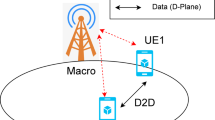Abstract
Administration request in cellular radio networks is for the most part heterogeneous and non-uniform, prompting lopsided topologies. This many-sided quality along with the various radio access advances, the radio channel and down to earth imperatives, make the radio network arranging process a testing job that generally rules out instinctive arrangements. In this paper, we define the structure that takes into account radio network arranging investigation to be performed with regards to a developmental large-scale smaller scale transfer blend approach, or wide region microcell arrangements. Scope, limit and cost prerequisites and in addition diverse down to earth imperatives, for example, reuse of existing 2G and 3G destinations, are considered along with a multi-target improvement calculation adjusted to the radio network arranging issue for 4G frameworks. In addition to other things, the created comes about feature two key issues: (a) the route towards high limit radio networks is to supplant large scale cells with various microcells that is in excess of one request of size higher, (b) advancing the radio network arrangement can diminish the cost/Mbps/km2 by elements of 4–20, contrasted with proportional macro cellular reference situations.





Similar content being viewed by others
References
Rajesh, M., & Gnanasekar, J. M. (2017). Path observation based physical routing protocol for wireless ad hoc networks. Wireless Personal Communications,97, 1267. https://doi.org/10.1007/s11277-017-4565-9.
Arjoune, Y., & Kaabouch, N. (2019). A comprehensive survey on spectrum sensing in cognitive radio networks: Recent advances new challenges and future research directions. Sensors,19(1), 126.
A, H., & U, K. (2019). Cooperative spectrum handovers in cognitive radio networks. In M. Rehmani & R. Dhaou (Eds.), Cognitive radio, mobile communications and wireless networks. EAI/Springer Innovations in Communication and Computing. Cham: Springer.
Samal, U. C., Appasani, B., & Mohanta, D. K. (2019). 5G communication networks and modulation schemes for next-generation smart grids (pp. 361–399). Singapore: Springer.
Ahmad, W. S. H. M. W., et al. (2020). 5G technology: Towards dynamic spectrum sharing using cognitive radio networks. IEEE Access,8, 14460–14488.
Lochert, C., Scheuermann, B., Wewetzer, C., Luebke, A., & Mauve, M. (2008). Data aggregation and pathside unit placement for a vanet traffic information system. In Proceedings of the fifth ACM international workshop on wireless inter-networking (pp. 58–65). ACM.
Karp, B., & Kung, H.-T. (2000). GPSR: Greedy perimeter stateless routing for wireless networks. In Proceedings of the 6th annual international conference on mobile computing and networking (pp. 243–254). ACM.
Lochert, C., Mauve, M., Füßler, H., & Hartenstein, H. (2005). Geographic routing in city scenarios. ACM SIGMOBILE Mobile Computing and Communications Review,9(1), 69–72.
Singh, S., & Agrawal, S. (2014). VANET routing protocols: Issues and challenges. In 2014 Recent advances in engineering and computational sciences (RAECS) (pp. 1–5). IEEE.
Lequerica, I., García Longaron, M., & Ruiz, P. M. (2010). Drive and share: Efficient provisioning of social networks in wireless scenarios. IEEE Communications Magazine,48(11), 90–97.
Rajesh, M., & Gnanasekar, J. M. (2016). Consistently neighbor detection for MANET. In 2016 International conference on communication and electronics systems (ICCES), Coimbatore, India (pp. 1–9). https://doi.org/10.1109/cesys.2016.7889967.
Xiang, Y., Liu, Z., Liu, R., Sun, W., & Wang, W. (2013). GeoSVR: A map-based stateless VANET routing. Ad Hoc Networks,11(7), 2125–2135.
Finn, G. G. (1987). Routing and addressing problems in large metropolitan-scale internetworks. ISI Research Report.
Lochert, C., Hartenstein, H., Tian, J., Fussler, H., Hermann, D., & Mauve, M. (2003). A routing strategy for wireless ad hoc networks in city environments. In Intelligent mobiles symposium, 2003. Proceedings (pp. 156–161). IEEE.
Nzouonta, J., Rajgure, N., Wang, G., & Borcea, C. (2009). VANET routing on city paths using real-time wireless traffic information. IEEE Transactions on Wireless Technology,58(7), 3609–3626.
Naumov, V., & Gross, T. R. (2007). Connectivity-aware routing (CAR) in wireless ad-hoc networks. In INFOCOM 2007. 26th IEEE International conference on computer communications (pp. 1919–1927). IEEE.
Shafiee, K., & Leung, V. C. (2011). Connectivity-aware minimum-delay geographic routing with vehicle tracking in VANETs. Ad Hoc Networks,9(2), 131–141.
Wu, D., Luo, J., Li, R., & Regan, A. (2011). Geographic load balancing routing in hybrid wireless ad hoc networks. In 2011 14th International IEEE conference on intelligent transportation systems (ITSC) (pp. 2057–2062). IEEE.
Author information
Authors and Affiliations
Corresponding author
Additional information
Publisher's Note
Springer Nature remains neutral with regard to jurisdictional claims in published maps and institutional affiliations.
Rights and permissions
About this article
Cite this article
Rajesh, M. Streamlining Radio Network Organizing Enlargement Towards Microcellular Frameworks. Wireless Pers Commun 113, 2463–2475 (2020). https://doi.org/10.1007/s11277-020-07336-9
Published:
Issue Date:
DOI: https://doi.org/10.1007/s11277-020-07336-9




